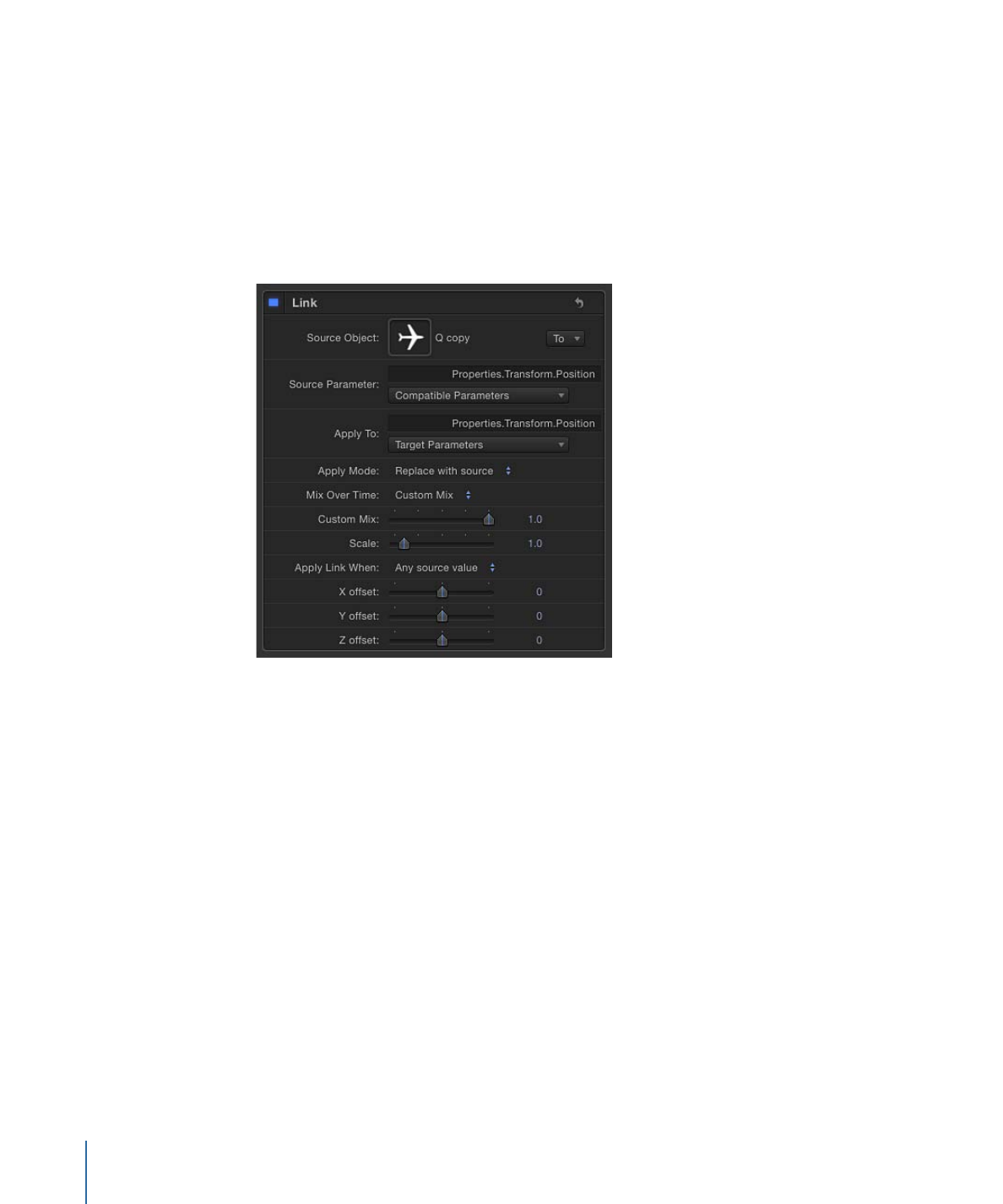
Link
The Link parameter behavior forces the value of one parameter to match that of another
“linked” parameter. The source behavior can be within the same object or from another
object. The linked parameters must contain numerical data. Parameters controlled by
checkboxes, menus, and other non-numeric values cannot be linked. The linked parameters
also must contain the same number of attributes. You cannot link a compound parameter
such as Scale X-Y-Z to a parameter such as Opacity which has only one slider. You can
however, link a compound parameter such as Scale X-Y-Z to Position X-Y-Z.
The values of the source parameter can be scaled to more accurately apply to the
destination parameter. For example, a source parameter with a range of 1–100 can be
scaled when applied to a parameter with a range of 0–1. The values can also be offset
from the source, and the effect can be mixed with the destination value to create different
effects.
The Link behavior can be applied to parameters animated with behaviors or keyframes;
however, it does not affect the parameter when the Start Values or End Values are zero.
When using the Link behavior to control an object’s position parameter, the linked
coordinates are based on the center point of the current group. So when an object is
linked to another object in the same group, it will share an identical position. However,
if the source object is in a different group, the coordinates might appear offset in space.
426
Chapter 9
Using Behaviors

If your goal is to match an identical position across groups with different center points,
you can create an invisible dummy object in the group containing the source, link it to
the source object, then use the Match Move behavior to copy the dummy object’s position
to that of the intended target. Match Move compensates for inter-group position offsets
and provides the option to attach one object to another or to mimic the source object’s
transformations. For more about Match Move, see
Motion Tracking Behaviors
.
You can also link to the group’s coordinates instead of the object’s, and use the Offset
parameters in the Link behavior to obtain the position you want. However, if that group
is subsequently added to another group, the linked object might not move as expected.
Note: When a link behavior is added, it is not enabled by default. To activate the behavior,
click the activation checkbox beside the behavior name in the Behaviors Inspector.
Parameters in the Inspector
Source Object:
The object in which the source parameter resides. Click the To pop-up
menu to select from the objects in the current project.
Source Parameter:
The Source Parameter (Compatible Parameters) pop-up menu shows
the parameter that serves as the source for the Link behavior and can be used to select
a new source parameter. Only parameters with the same value type and number of
attributes as the parameter selected in the Apply To (Target Parameters) pop-up menu
appear here.
Note: When possible, Source Parameter defaults to the parameter chosen in the Apply
To row (described below).
Important:
Changing the Apply To (Target Parameters) setting changes which parameters
appear in the Source Parameter pop-up menu. If you cannot find the parameter you are
looking for, you might need to choose a Target Parameter to which you can link.
Apply To:
The Apply To (Target Parameters) pop-up menu shows the parameter affected
and can be used to reassign the behavior to another parameter. Because only some
parameters can be linked, you must set the Apply To parameter before eligible parameters
will appear in this pop-up menu.
Apply Mode:
Pop-up menu to specify how the values from the source parameter affect
the target parameter. The choices include:
• Add to source: Choosing this option will add the source parameter value to the existing
value of the target parameter.
• Multiply by source: Choosing this option will multiply the source parameter value with
the existing value of the target parameter.
• Replace with source: Choosing this option will replace the existing value of the target
parameter with that of the source parameter.
427
Chapter 9
Using Behaviors

Mix Over Time:
Pop-up menu to set how rapidly the source parameter values begin to
affect the target parameter. Options include: Ease In, Ease Out, Ease In/Out, Accelerate,
Decelerate, Accelerate/Decelerate, and Custom Mix.
Mix Time Range:
When the Mix Over Time is set to an Ease or Acceleration option, this
slider controls over how many frames the ease or acceleration occurs.
Tip: Ease In and Accelerate begin at the In point of the Link behavior, and Ease Out and
Decelerate end at the Out point of the Link behavior. Therefore, you can trim the Link
behavior in the Timeline to specify where the ease or acceleration begins and/or ends.
Custom Mix:
When the Mix Over Time parameter is set to Custom Mix, this slider can be
animated to create a user-determined mix between the source and target parameter
values.
Scale:
Slider to specify a value to be multiplied with the Source parameter before it is
applied to the target.
Apply Link When:
Pop-up menu that enables you to limit when values from the source
are applied to the target. There are five choices:
• Any source value: When this item is selected, no limits are placed on the source
parameter values. An offset slider for each setting associated with the source parameter
appears at the bottom of the Behaviors Inspector. If the source parameter has a single
slider, such as Opacity, a single offset slider appears. If the source parameter has multiple
sliders, such as Position X-Y-Z, offset sliders for each of those settings appear.
• Source value above minimum: When this item is selected, the link applies only when
the source value exceeds a defined minimum value. If the source value falls below the
defined minimum, the link behavior stops. When selected, the Clamp Source Values
Within Range checkbox as well as offset and minimum sliders for each setting associated
with the source parameter appear at the bottom of the Behaviors Inspector. If the
source parameter has a single slider, such as drop shadow Blur, an offset and a minimum
slider appear for that setting. If the source parameter has multiple sliders, such as Scale
X-Y-Z, offset and minimum sliders appear for each of those settings.
• Source value below maximum: When this item is selected, the link applies only when
the source value stays below a defined maximum value. If the source value exceeds
the defined maximum, the link behavior stops. When selected, the Clamp Source Values
Within Range checkbox as well as offset and maximum sliders for each setting associated
with the source parameter appear at the bottom of the Behaviors Inspector. If the
source parameter has a single slider, such as shape Roundness, an offset and a maximum
slider appear for that setting. If the source parameter has multiple sliders, such as
Rotation X-Y-Z, offset and maximum sliders appear for each of those settings.
428
Chapter 9
Using Behaviors

• Source value between min and max: When this item is selected, the link applies only
when the source value stays within a defined range. If the source value falls below the
defined minimum, or exceeds the defined maximum, the link behavior stops. When
selected, the Clamp Source Values Within Range checkbox as well as offset, minimum,
and maximum sliders for each setting associated with the source parameter appear at
the bottom of the Behaviors Inspector. If the source parameter has a single slider, such
as shape Feather, one set of three sliders (offset, minimum, and maximum) appears for
that setting. If the source parameter has multiple sliders, such as Fill Color (red, green,
blue), sets of three sliders appear for each of those settings.
• Source value outside min and max: When this item is selected, the link applies only when
the source value stays outside of a defined range. If the source value falls above the
defined minimum, or below the defined maximum, the link behavior stops. When
selected, the Clamp Source Values Within Range checkbox as well as offset, minimum,
and maximum sliders for each setting associated with the source parameter appears
at the bottom of the Behaviors Inspector. If the source parameter has a single slider,
such as Outline Width, one set of three sliders (offset, minimum, and maximum) appears
for that setting. If the source parameter has multiple sliders, such as Shear X-Y, sets of
three sliders appear for each of those settings.
Clamp Source Value Within Range:
This checkbox becomes available when the Apply
Link pop-up menu is set to a choice requiring a minimum or maximum value. When
selected, values that exceed the defined range are pinned to the highest or lowest
allowable setting.
(Parameter) offset:
This slider allows you to create a constant offset between the source
parameter value and the value applied to the target parameter.
(Parameter) min:
When the Apply Link When pop-up menu is set to “Source value above
minimum,” “Source value between min and max,” or “Source value outside min and max,”
a “min” slider appears for each component of the source parameter. Adjusting this slider
defines a minimum value to limit when the link behavior is active.
(Parameter) max:
When the Apply Link When pop-up menu is set to “Source value below
maximum,” “Source value between min and max,” or “Source value outside min and max,”
a “max” slider appears for each component of the source parameter. Adjusting this slider
defines a maximum value to limit when the link behavior is active.
HUD Controls
The HUD lets you set all parameters and change the parameter source and target.
429
Chapter 9
Using Behaviors